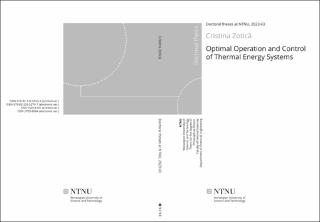| dc.description.abstract | This thesis explores broad topics in the area of optimal control and operation of thermal energy systems, and it is divided into three parts.
Part I is entitled Optimal operation and control of heat-to-power cycles: a new perspective from a systematic plantwide control approach. It aims at giving an understanding of the operation and control problem for heat-to-power cycles from a plantwide perspective. The analysis concerns a steam cycle with one pressure level and producing power only. The reason for choosing this process is that it is an extremely important thermal process where well-functioning control structures have been developed over many years. The aim was to study the present control schemes to see if they could be improved by applying a systematic plantwide control approach. The contribution is twofold, consisting of a steady-state, and a dynamic analysis. The former considers the optimal operation and control problem for a heat-to-power cycle and provides a clear and systematic procedure for identifying the operational objectives, specification or constraints and degrees of freedom from a steady-state point of view. The latter examines the dynamic performance of different control structures that can be used to implement optimal operation.
Part II is entitled Transformed inputs for linearization, decoupling and feedforward control. It aims at providing a systematic theory for many nonlinear model-based calculation blocks used in power plants and the chemical industry. These blocks include but are not limited to cascade control, ratio, decoupling or nonlinear feedforward. It introduces inputs transformation derived from a nonlinear process model with the purpose of transforming a nonlinear system into a linear and decoupled system which also has feedforward disturbance rejection. The main assumptions are that there are as many outputs as inputs, and that disturbances, and in some cases additional states can be measured. The transformed inputs can be derived from both a static and a dynamic model. For dynamic systems, this theory is similar to feedback linearization for systems with relative order 1. For higher order systems, we may introduce additional process measurements to account for unmeasured process dynamics or may introduce a chain of transformations. Three implementations are proposed: model-based, feedback-based (cascade), and a combination of the two. The first option inverts the process model and, with perfect measurement and perfect model, gives perfect feedforward action, linearization and decoupling both dynamically and at steady-state. Because it requires an inversion, it cannot handle process delays and unstable zero-dynamics (equivalent to right-hand plane zero for linear systems). The second option uses a fast inner controller and does not require inverting the process model. This is important for higher order systems where the input (u) does not appear explicitly in the output (y) model equation but has an effect through some internal states (w). However, the response is not perfect dynamically because of the dynamics introduced by the inner controller. Several simulation examples are presented, e.g., control of heat exchangers, steam networks and mixing processes. These include case with a static model used to derive the input transformation and applied to a dynamic process model. Because of the model difference, the response may not be perfect dynamically, but some disturbance rejection properties are kept. The process-model mismatch and unmeasured dynamics are handled by an outer linear PID controller.
Finally, Part III is entitled Handling constraints on manipulated variables used for inventory control to balance supply and demand. Specifically, it studies implementing optimal operation to cover cases of manipulated variables (MVs) saturation. The proposal is to use classical decentralized control elements such as split range control or controllers with different setpoints in combination with min or max selectors. Two applications are analyzed. The first advocates the use of a bidirectional inventory control structure that is able to maximize production when temporary or permanent bottlenecks occur for multiple units in series by employing the buffer inventories at intermediate storage. This bidirectional inventory control scheme has for each inventory two controllers, one for the inflow and one for the outflow, with high and low inventory setpoints, respectively. The inventory can typically be liquid (level) or gas (pressure). When production cannot be maintained without breaching physical constraints on the inventory, this control structure automatically reconfigures the loops for consistent inventory control, which means that it is radiating around the throughput manipulator to assure local consistency and feasible operation. The second application is a district heating network composed of a waste heat boiler, an electric boiler, a dump, a hot water storage tank, and a set of consumers. Three alternatives for the supervisory control layer are compared: split range control, controllers with different setpoints, and model predictive control. The closed-loop performance in the face of time-varying supply and demand and using constant electricity prices is evaluated. All alternatives were found to give similar performance. Controllers with different setpoints is the easiest to implement, while model predictive control is the most difficult. | en_US |
